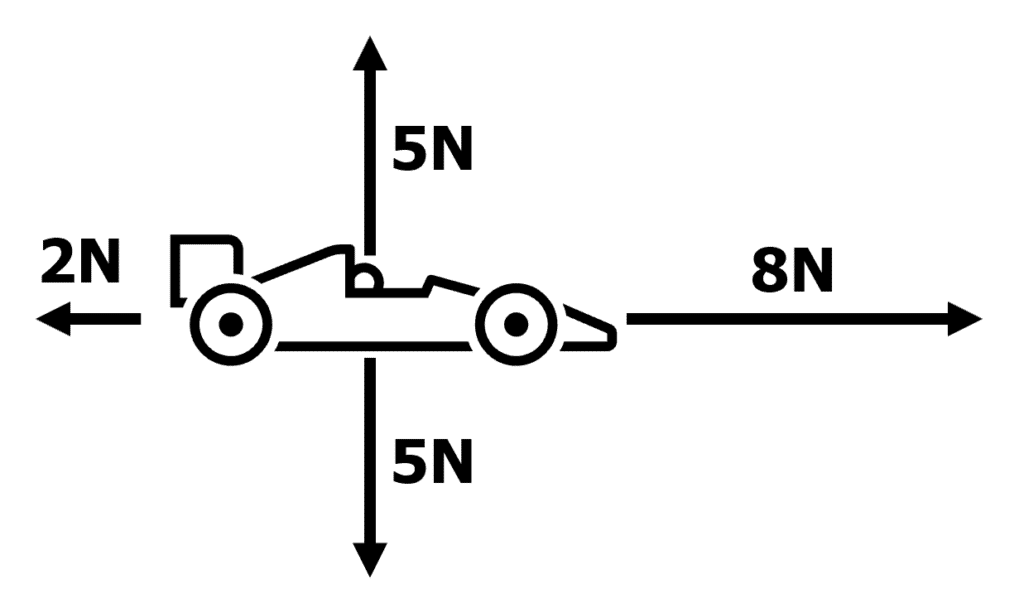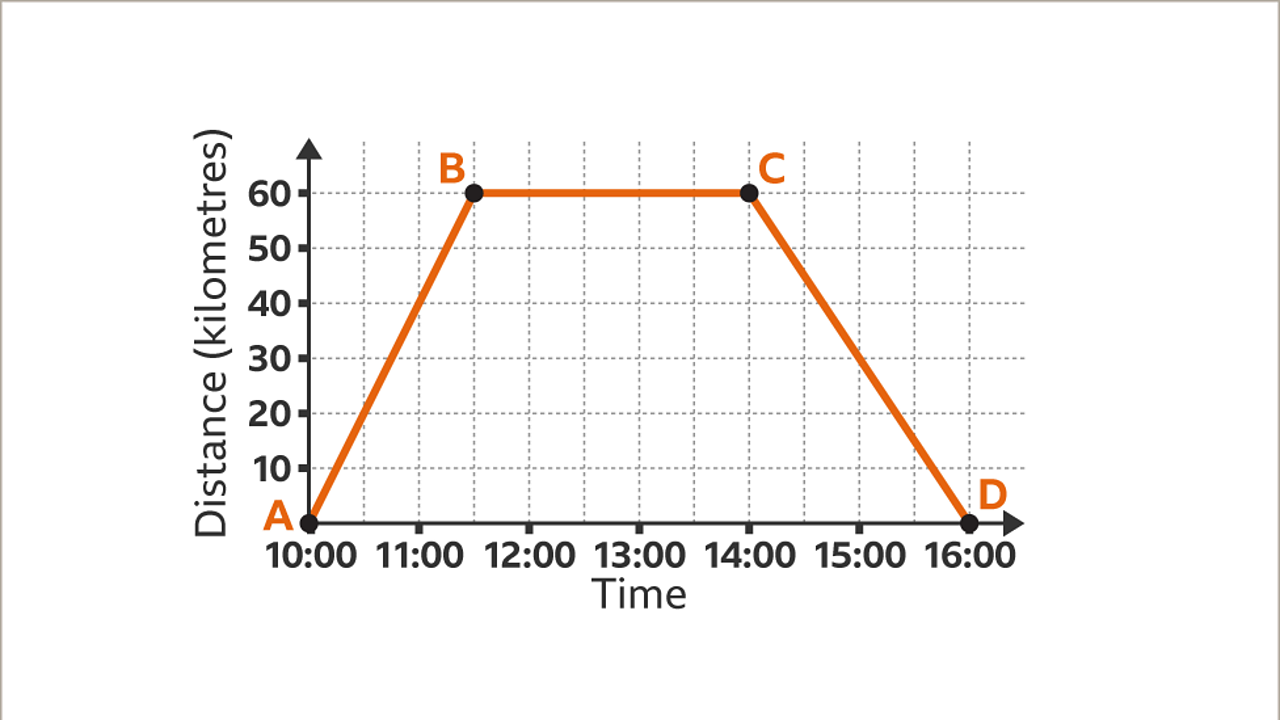State the principle of conservation of Momentum.
When two or more objects collide/explode, their total momentum is conserved, provided that no external resultant force acts on the system.
Gradient of a distance-time graph gives us what?
Gradient of a displacement-time graph gives us what?
- Speed
- Velocity
What is the difference between a vector and a scalar quantity? Give an example of each.

What is the resultant force?
A scalar quantity has only size. It does not have a direction. Ex: Temperature, distance, weight.
A vector quantity has both size (magnitude) and direction. Ex: Force, mass, energy.
6N to the right.
Explain the difference between heat and temperature
Temperature is a measure of how hot a material is. it is measure by various instruments, with the most common one being a thermometer.
Heat is defined at the amount of thermal energy that a body possesses. Its unit is the Joule (J).
State the symbol, charge and the location in the atom of a proton, electron and neutron.
Proton: p, positive, in nucleus.
Electron: e, negative, in shell.
Neutron: n, no charge, in nucleus.
Differentiate between elastic and inelastic collision.
In an elastic collision:
o Momentum is conserved
o Kinetic Energy is Conserved
In an inelastic collision:
o Momentum is conserved
o Kinetic Energy is not conserved
Define stopping, thinking and braking distance.
Thinking distance is the distance the vehicle travels in the split-second between the driver noticing the hazard and applying the brakes.
Braking distance is the distance the vehicle travels during its deceleration while the brakes are being applied.
Stopping distance is the sum of the thinking and braking distances
What is inertia?
Inertia is the resistance of a body to change its velocity.
• A stationary body will resist movement.
• A body moving with uniform velocity will resist being stopped, or changing its velocity.
Heat always flows from a body of _____ temperature to a body of ______ temperature until _______________________ is reached.
Explain the experiment of the bimetallic strip.
Heat always flows from a body of higher temperature to a body of lower temperature until thermal equilibrium is reached.
When matter is heated, objects expand whilst when cooled, they contract. Let’s say that metal A is iron and metal B is brass. Brass expands and contracts more than iron can. Hence the curving of the strip. Once the strip returns to room temperature, it returns straight.
Differentiate between Conductors, Insulators and semiconductors. Give an example of each.
Conductors have vast numbers of very mobile electrons (free electrons). The electrons are loosely bound to their atoms and so charge can flow freely. (ex. copper)
Insulators are materials through which charge does not flow. The electrons of the atoms in an insulator are not free to move around. They are strongly bound to their atoms. (ex. plastic)
Semiconductors are materials in between conductors and insulators. They are poor conductors when cold but their conductivity increases at higher temperature. (ex. silicon)
What is impulse? State examples of real-world application
Impulse is the change in momentum of an object.
- For soft objects, the force of collision acts for a long length of time.
- For hard, rigid objects the force of collision acts for a short length of time.
Ex: crumple zones, seat belt, in rugby, hammer, packaging.
Explain the motion during AB, BC, CD.

AB: Constant Speed
BC: No Motion
CD: Constant Speed
State Newton's three laws of motion.
1st Law: A body stays at rest, or if moving continues to move with uniform velocity, unless an external unbalanced/resultant force acts on it.
2nd Law: The acceleration of a body is directly proportional to the unbalanced force, when the mass is kept constant, and inversely proportional to the mass of the body, when the unbalanced force is kept constant.
3rd Law: For every action there is an equal and opposite reaction.
2 kg of steel needs 9000 J of energy to raise its temperature by 10 ºC. Calculate the specific heat capacity for steel.
Q = mc delta tita
9000 = (2)c(10)
450 J/kg/.C = c
The forces of attraction or repulsion between two charged objects depends on:________________
• The quantity of charge on each object. The larger the charge, the larger the force.
• The distance between two objects. The smaller the distance, the larger the force.
A bullet of mass 10 g (0.01 kg) is fired at 400 m/s from a rifle of mass 4 kg. What is the recoil velocity of the rifle? Recoil is the moving backwards of the body after shooting
Total momentum before explosion = total momentum after explosion
mv = m1v1 + m2v2
0 = 0.01 (400) + 4(v)
-1 m/s = recoil velocity
Explain the motion in AB, BC, CD.
The area under the graph gives us what?
AB: Constant Acceleration
BC: Constant velocity
CD: Constant deceleration
Area under the graph gives us the total distance.
A bobsleigh of mass 500 kg is pushed at the start with a force of 2000 N. What is its initial acceleration?
F = ma
a = F/m
a = 2000/500
a = 4m/s2
Discuss the natural convection currents
During the day, the land heats up faster than the sea, because of the low specific heat capacity of the land compared to that of the water. The air above the land starts to heat and so it rises. The cooler air from the sea moves in to replace this hot air. This causes a cool sea breeze.
At night, the land cools down quicker than the sea. The air above the water is warmer and it rises. Cooler air from the land moves out to replace this hot air. This causes a cool land breeze.
Explain how lightning happens.
Lightning is a giant spark of electricity in the atmosphere or between the atmosphere and the ground. In the initial stages of development, air acts as an insulator between the positive and negative charges in the cloud and between the cloud and the ground; however, when the differences in charges becomes too great, this insulating capacity of the air breaks down and there is a rapid discharge of electricity that we know as lightning.
Trolley A of mass 1 kg is pushed on a track with a velocity of 2 m/s. trolley B of mass 4 kg is moving in the opposite direction at a velocity of 3 m/s. When they collide, they stick together. Calculate their velocity after collision.
Total momentum before collision = total momentum after collision
m1v1 + m2 v2 = mv
(1)(2) + (4)(3) = (5) (v)
2.8m/s = v
An object is dropped from a helicopter at a height of 45 m above the ground. If the helicopter is at rest...
a). How long does the object take to reach the ground?
b). What is the velocity upon arrival?
a). s=1/2 gt2
sqr rt 2s/a = t
t = 3s
b). v= u + gt
v = 30m/s

A: Acceleration - When a skydiver jumps from a plane, his weight pulls him down and he accelerates at a rate of 10 m/s2 as the air resistance is still small. This is due to the unbalance force, which is caused by his weight.
B: Constant Velocity - As time goes by, the air resistance increases until it is equal to the weight of the skydiver. At this particular point, since the forces on the skydiver are balances,
he stops accelerating and drops with constant velocity. This constant velocity is called terminal velocity.
C: Deceleration - Once the parachute is opened, the air resistance is larger than the weight
and the skydiver experiences a deceleration, but this slowly decreases until it is again equal to the weight of the parachutist.
D: Constant velocity - A second, lower, terminal velocity is reached at this point and the skydiver keeps falling at a constant speed until he lands. On land, his weight is balanced by the upward reaction from the ground.

Explain the properties of a solar water heater to facilitate or prevent heat transfer.
• The glazing sheet works like a 'greenhouse effect' meaning that short-wavelength IR rays coming from the Sun penetrate through the glass sheet and are absorbed by the black surface. The radiant heat is re-emitted by the pipes as long-wavelength IR and cannot penetrate back out of the glass sheet. Thus, the heat radiation is trapped inside the glass panel, like a greenhouse.
• The pipes and the backplate are blackened. Black surfaces are better absorbers of heat than shiny or light-coloured surfaces.
• The pipes are made of copper. Copper is a good thermal conductor so that heat can reach the water inside the pipes.
• The water inside the solar panel flows through a long winding pipe. A longer pipe has a bigger surface area thus more heat waves are absorbed by the water inside.
• There is a foam or aluminium insulation backing to the panel. The foam is a poor conductor and this reduces the heat escaping from the copper pipes to the surrounding. The aluminium reflects heat inside the heater.
When insulating materials rub against each other, they may become electrically charged . Electrons , which are negatively charged, may be 'rubbed off' one material and on to the other. The material that gains electrons becomes negatively charged whilst the other is positively charged.